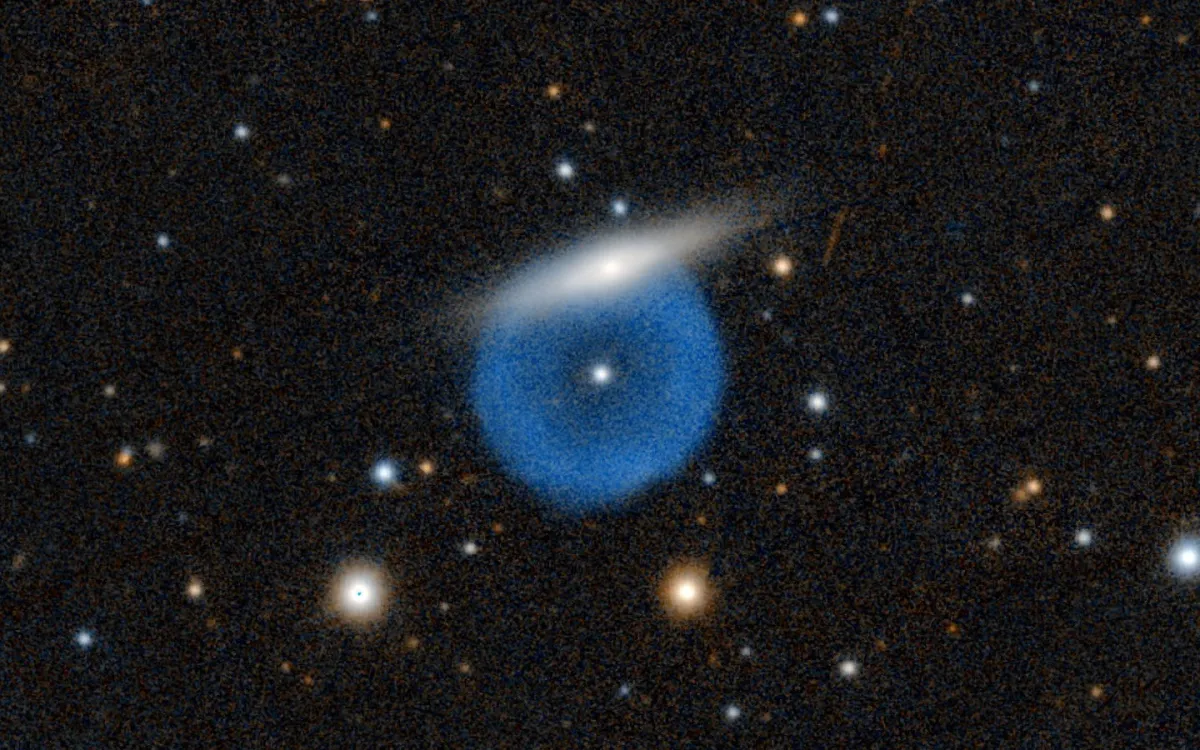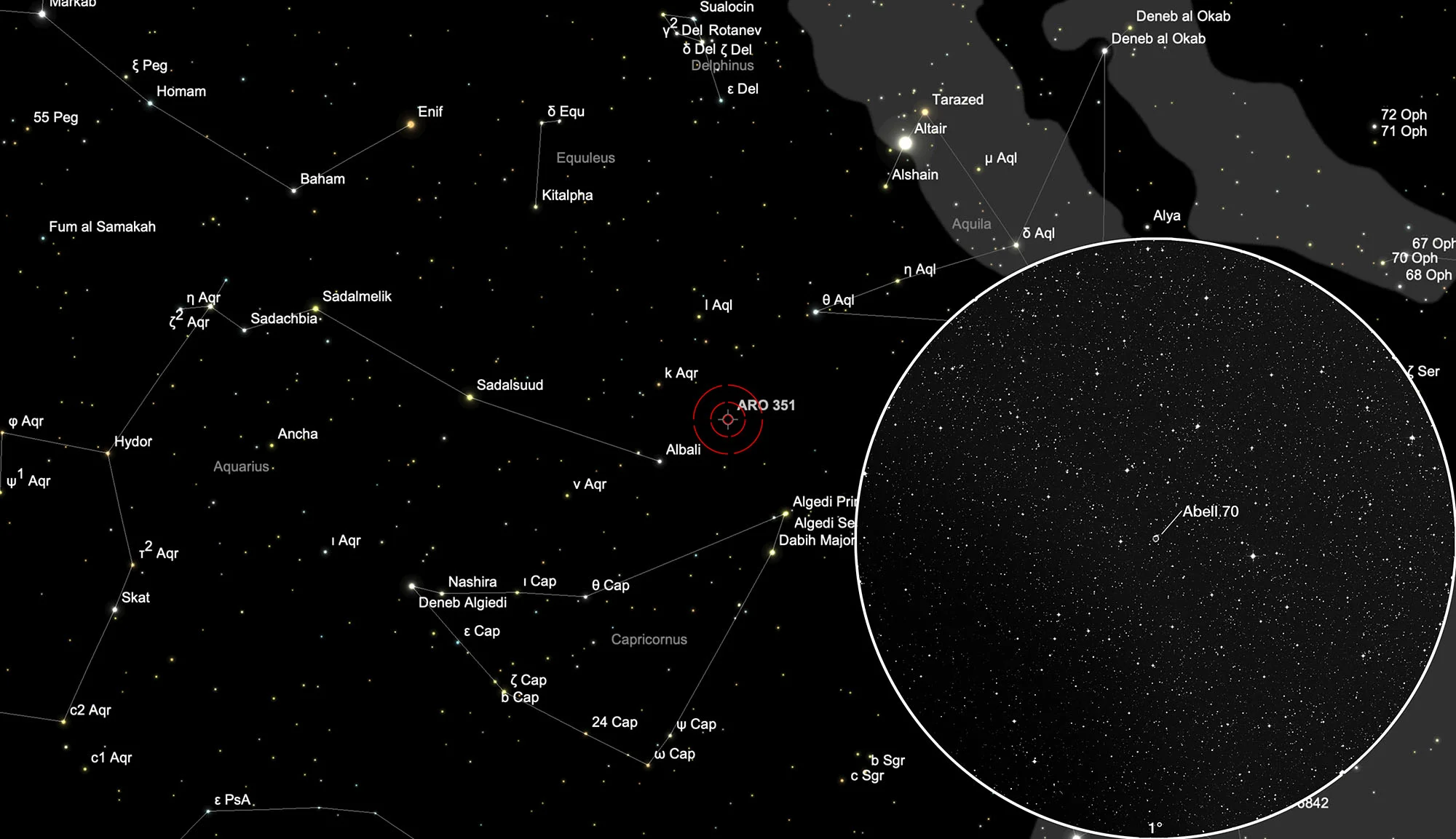Abell 70 with Galaxy PMN J2033-0656

History
The annular planetary nebula Abell 70 was discovered on the «Palomar Observatory Sky Survey» photo plates by George Abell in 1955. The designation in the first publication was A55 57 and in the second A66 70. [331, 332]
Physical Properties
It is a very special deep-sky object: At its northern edge it is illuminated by a spindle-shaped background galaxy. The galaxy, which is probably several million light-years away from us, appears to be about the same size in length as the relatively close PN, which happens to be in the line of sight between us and the distant galaxy. Distance estimates from Abell 70 range from 2.4 to 3.5 kiloparsecs. The PN is moving towards us at a radial speed of around 79 km/s. Measurements of the expansion speed based on the OIII lines showed that the nebula expands at 38 km/s. [141]
| Designations | PN G038.1-25.4: A 70, PK 38-25.1, A55 57, ARO 351, VV' 536 |
| Right Ascension (J2000.0) | 20h 31m 33s |
| Declination (J2000.0) | -07° 05' 21" |
| Dimensions | 42." (optical) |
| Radial Velocity | -79.0 ± 18.0 km/s |
| Expansion Velocity | 37.8 (O-III) km/s |
| C-Star Designations | AG82 410 |
| C-Star Magnitude | B: 19.1 |
| Discoverer | ABELL 1955 |
Galaxy PMN J2033-0656
The galaxy behind the northern edge of the PN is apparently a radio galaxy with the designation PMN J2033-0656 from the Parkes-MIT-NRAO Survey - this according to the information from the NASA Extragalactic Database (NED), which refers to an article in APJS (1995, 97, p.347, Griffith). Other names are LEDA 187663, 2MASX J20313312-0705014 or WISEA J203133.10-070501.5. The redshift z is 0.019423, which corresponds to a speed of 5823 km/s.
| Name | PMN J2033-0656 |
| Object Type | Radio Source |
| Right Ascension (J2000.0) | 20h 33m 37s |
| Declination (J2000.0) | -06° 56' 17" |
| Identifiers | GLEAM J203336-065613; NVSS J203336-065618; PMN J2033-0656; SPASS J203334-065729; TGSSADR J203336.8-065616 |
Finder Chart
The unequal pair lies between the constellations Aquila (Eagle) and Aquarius (Water Bearer). A good starting point is the 3.8 mag bright star Albali (ε Aquarii). About 4.5 degrees northwest of it in the direction of θ Aquilae you will experience an unusual encounter. A large telescope aperture and a dark sky are essential for the visual observation of this fine pair of objects. On 29 July it is in opposition to the Sun and crosses the meridian at local midnight. This object is best observed in the months of March to January.
Visual Observation
400 mm Aperture: The planetary nebula Abell 70 is not easy to find, as hardly any prominent star patterns help with orientation. Without a filter, there is no trace of either the PN or the background galaxy. With O-III filter, only a small round spot of the PN is visible in the 21 mm Ethos eyepiece (85x) with averted vision. — 400 mm f/4.5 Taurus Dobsonian, Hasliberg, 18. 8. 2023, SQM 21.2, Bernd Nies
762 mm Aperture: In the planetary nebula Abell 70, the background galaxy is more clearly visible without the use of a filter and completely disappears when using an O-III filter. Abell 70, on the other hand, stands out clearly with the filter, but both objects can only be viewed simultaneously without a filter. — 30" f/3.3 SlipStream Dobsonian, Hasliberg, 25. 7. 2012, SQM 21.36, Eduard von Bergen
